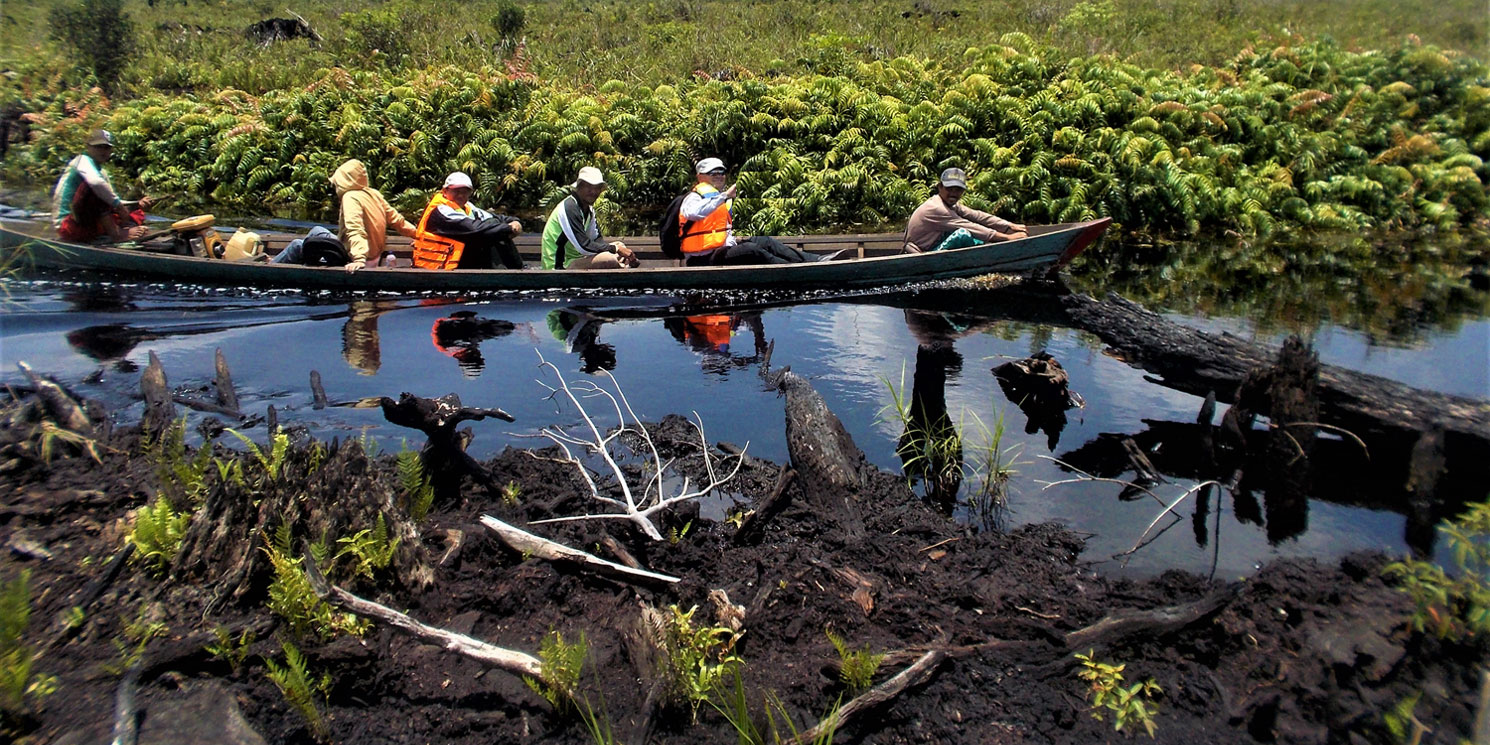Program Overview
MCC’s $474 million Indonesia Compact (2013-2018) included the $288 million Green Prosperity (GP) Project that aimed to increase economic productivity and reduce land-based greenhouse gas (GHG) emissions. The project, through the GP Facility, provided funding to three grants with co-financing totaling $18.4 million, which contained, among other work, peatland rewetting and canal blocking through the placement of dams to reverse surface water outflow and raise water levels. The focus of parts of these grants was to rewet drained peatland to reduce fire risk and GHG emissions, and also included over $3 million in co-financing. In addition, each grant funded alternative livelihoods components to help communities adjust to the changes from the rewetting and improve agricultural productivity.
Evaluator Description
MCC contracted Integra Government Services International to conduct an independent final performance evaluation of the GP Project’s peatland management grants. Full report results and learning: https://data.mcc.gov/evaluations/index.php/catalog/239.
Key Findings
Design of Grants
- The GP objectives were to increase productivity, reduce reliance on fossil fuels, and reduce land-based GHG emissions by expanding renewable energy, improving land use practices, and better manage natural resources. The peatland activities were designed to achieve GP objectives, and were based on solid logic that could be expected to lead to desired outcomes.
Implementation Lessons
- Peatland rewetting could reduce fires, provided that long-term maintenance mechanisms are in place. While insufficient time had passed to measure real progress, long-term commitment of the communities to development in the locations where implementation occurred will contribute significantly to successful outcomes.
- Each of the grantees demonstrated the skills necessary to implement their grants, but there was a lack of provisions for the sustainability of the canal rewetting process.
Grant Effectiveness and Impact
- Stakeholder attitudes about the grants’ effectiveness were positive because the grants targeted community well-being through livelihood enhancements such as tree crops, organic fertilizers, and improved processing tools and methods, as well as through protection from burning peat.
Sustainability
- In the case of wooden canal blocking systems, there is capacity for sustainability as community members were trained and employed for construction in two of the grants. However, the challenge is the high costs of the labor and materials required, which participating communities pointed out as a difficulty.
- No concrete mechanism was put into place to support the ongoing maintenance of key investments. It is unclear whether the Indonesian Peatland Restoration Agency (Badan Restorasi Gambut, or BRG) will be able to finance the dam maintenance.
Evaluation Questions
This final performance evaluation was designed to answer questions specifically about the peatland grant portfolio, including:
- 1
Were the activities in the peatland portfolio designed to achieve the GP objectives? - 2
What lessons can be learned from grant implementation? - 3
What was the effectiveness and impact of the grants? - 4
How sustainable are the outputs of the grants?
Detailed Findings
Design of Grants
The GP objectives were to increase productivity, reduce reliance on fossil fuels, and reduce land-based GHG emissions by expanding renewable energy, improving land use practices, and better management of natural resources. All of the activities in the peatland grants portfolio were designed to achieve the GP objectives. All interventions were based on solid logic and most were rooted in evidence. The exception is the revegetation activities, which were weakly supported by economics or ecological science.
Implementation Lessons
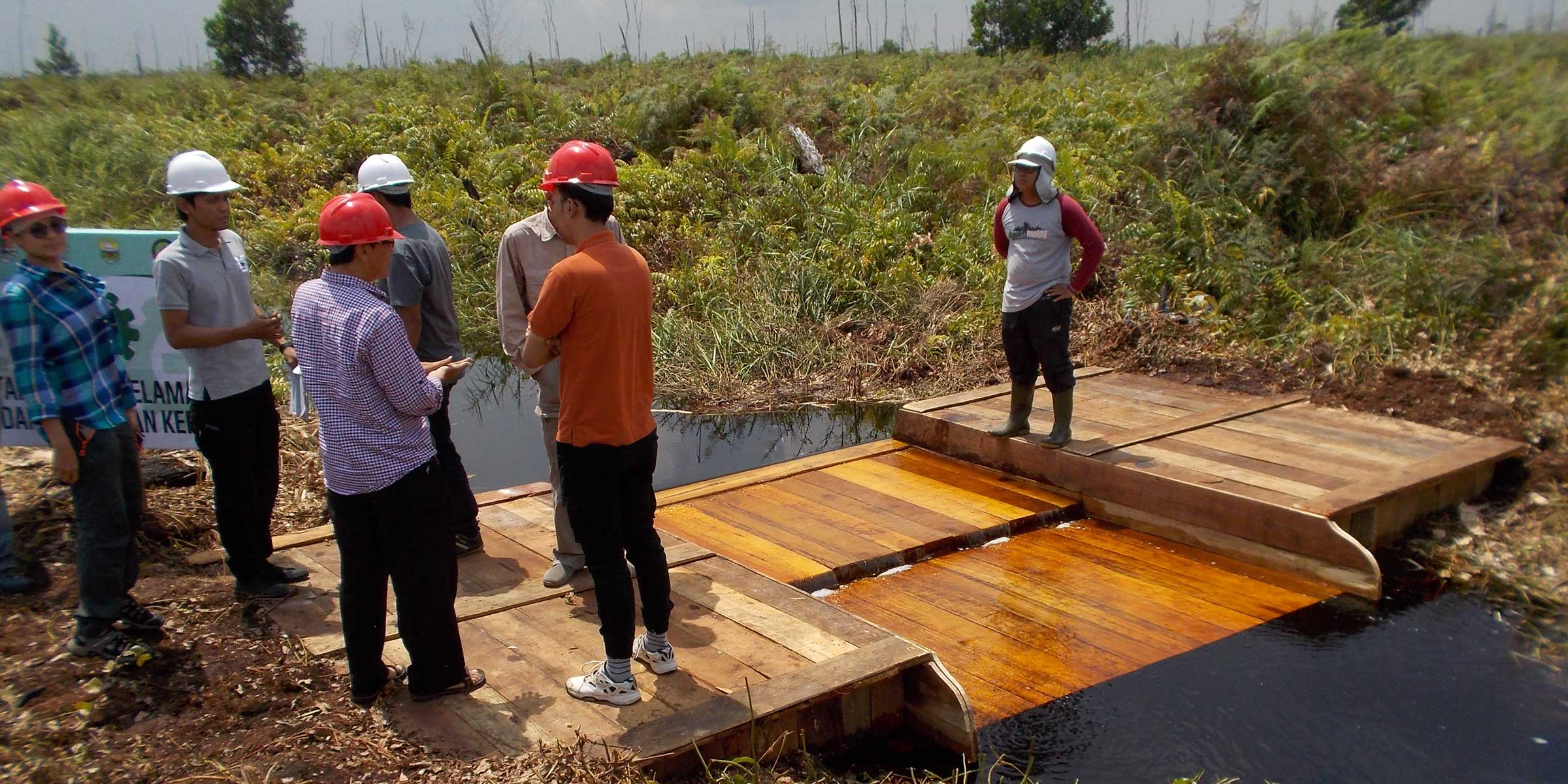
A wooden drainage canal blocking system in Berbak National Park, one of the two major designs to slow water movement in peatland drainage canals in an effort to rewet and restore peatland.
Major challenges to improve the long-term management of peatland included incompatible land uses (e.g., palm plantations) that constrained rewetting, a lack of coordination between provincial and national authorities, and administrative and policy delays. For example, the three grants designed the placement of barriers within drainage canals to slow or stop drainage from the peatlands. Remote sensing suggests successful implementation. However, it is not yet possible to predict if and how these barriers will survive over time. Further, there was limited evidence of direct capacity building in the central government, specifically the BRG. Senior staff interviewed in Jakarta were unaware of any training that had taken place and of training materials provided.
Grant Effectiveness and Impact
All of the communities that opted into the canal blocking supported it, primarily as a fire prevention strategy after the fires in 2015. Each of the grant recipients had to adapt their canal blocking approach to community needs. Accommodations and compromises about the siting, height, and design of canal barriers ultimately produced designs that satisfied community needs. In the case of two out of three grants, community members were employed in the construction of the canal barriers.
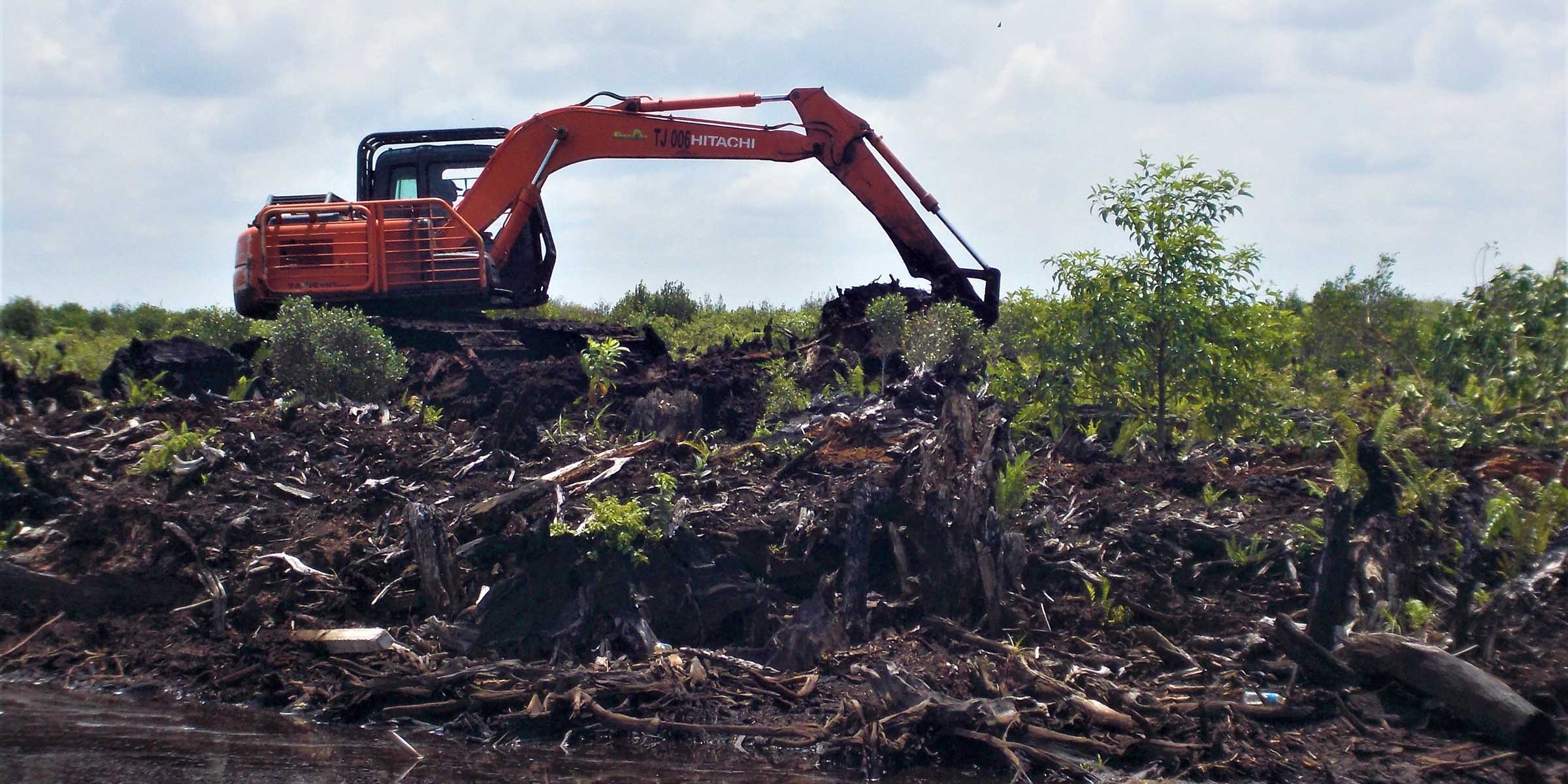
The second main method of blocking peatland drainage canals is to use dams made of compressed peat. Here a back-hoe moves peat into place to block a drainage canal.
Revegetation was concentrated in two sites. However, because the cost of revegetation is high, and there is urgency to protect against catastrophic fire and GHG emissions via rewetting, it would have been more effective to direct money spent on revegetation to rewetting, and depend on the natural plant growth process (i.e. natural plant succession) in the near term. Planting economically desirable tree species does not address the most urgent need of fire prevention.
All grantees made use of the landscape/lifescape analysis in planning livelihood approaches. The analysis is a participatory assessment which seeks to understand how social structures and social context affect the livelihoods of communities and, in turn, how these factors shape the use of natural resources and the potential to manage them well within a particular landscape. One grantee indicated that it will continue to use this tool through its long-term commitment to the grant area (with other sources of financial support), and thus has more opportunity to mainstream the use of the landscape planning tools and maps developed through the GP Project.
Given the short time span and limited data on dam performance, it is not possible to determine the long-term outcomes. It may take several years for the treatment areas to reach their full potential for peatland restoration; meanwhile, they are still at risk of fire, especially those that used a partial rewetting approach.
Sustainability
There is no evidence that sustainability had been addressed. BRG, which was established in 2016, is nominally responsible for maintaining the dams once built, but BRG’s future is uncertain due to its limited mandate. Although the dams have been built as proposed and are functional one year after construction, specific resources to support the maintenance of investments could not be identified.
Economic Rate of Return
- 20 - 24%
MCC Original Estimate - 1.5 - 24%
Evaluation-Based Estimate
When planning investments in a compact with a developing country, MCC considers a 10% economic rate of return (ERR) as the threshold to yield sufficient returns for that country’s citizens. The ex-ante grant ERRs were calculated by MCA-Indonesia economists and reviewed by MCC. The range of the original ERRs for the three grants are: 23.83 percent, 20.74 percent, and 19.96 percent. Their respective evaluation-based ERRs are: 8.63 percent, 1.51 percent, and 24.20 percent. Both the ex-ante and the evaluation-based ERRs look at the entire grant, not just the peatland components. The main driver of the lower evaluation-based ERR was an overestimate of the value of fire damage in the ex-ante ERR in two of the peatland grants. One of these grants also excluded maintenance costs and overestimated benefits to smallholder producers in the ex-ante ERR.
MCC Learning
A government partnership is critical early in development to ensure there is mutual understanding for the project to enable post-compact sustainability.
Grant facilities should ensure that a database of grant documentation and contact information exists in a form that is navigable by an independent evaluator to facilitate evaluation.
Evaluation Methods
This mixed-methods ex-post performance evaluation took place one year after the Indonesia Compact closed. The evaluation reviewed the implementation, compliance, and effectiveness of the grants after the close of the GP Project. The exposure period for the completed peatland grants is roughly one year.
This evaluation used both primary and secondary data. Primary data collection occurred in June 2018 and from May to June 2019, which included:
- 37 key informant interviews with MCA-I staff, MCC staff, grantees, village leaders, community beneficiaries, and local and national Government of Indonesia representatives.
- Eight focus group discussions with over 75 individuals from beneficiary communities.
- Observations at three completed grant sites in the Jambi province to examine the grant activities.
Secondary data included satellite remote sensing data to examine the grant areas and project documentation such as grant proposals, grant deliverables, feasibility studies, and MCA-I and compact documents.
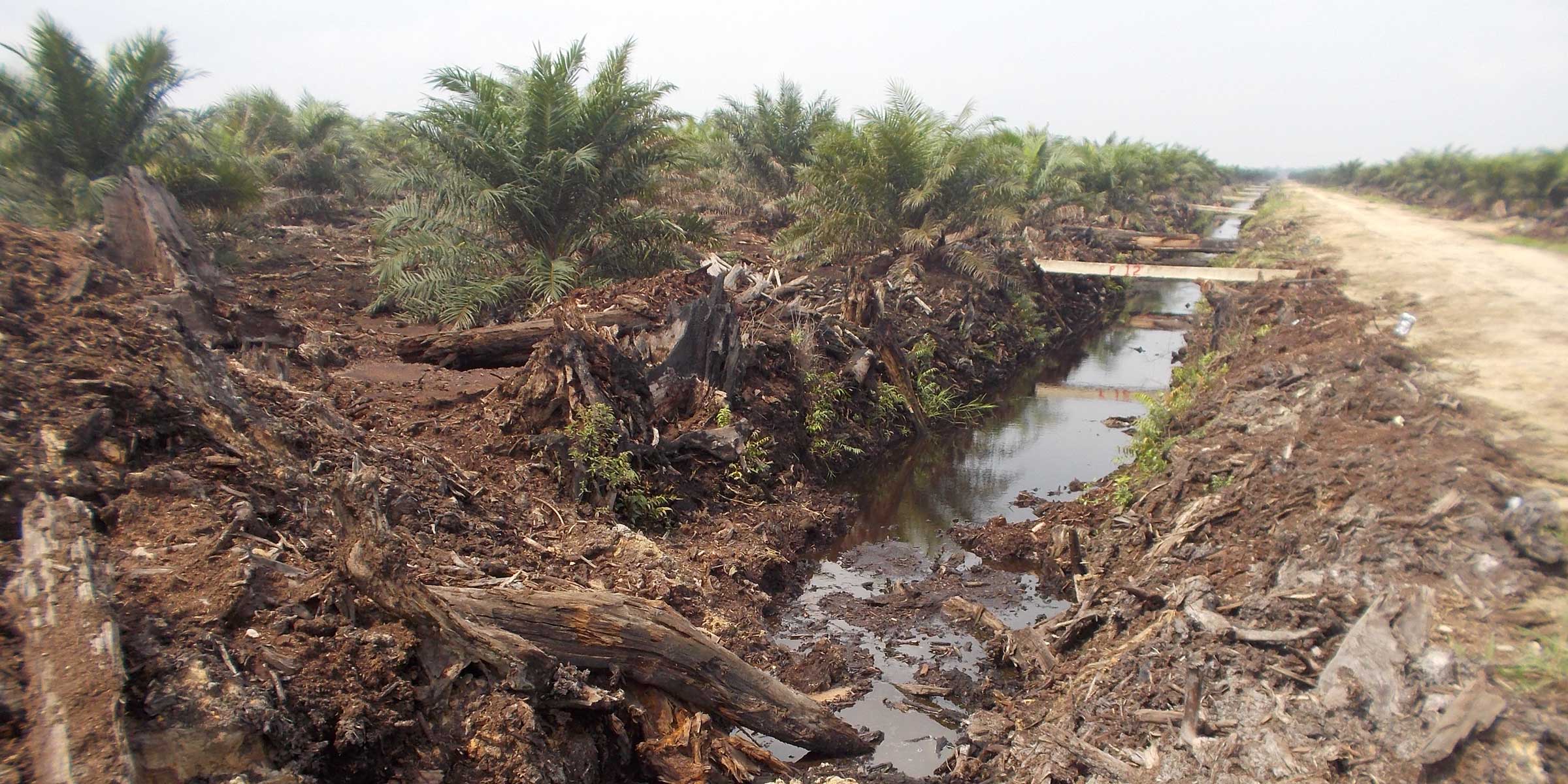
Much of the loss of native peatland in Indonesia is due to conversion to oil palm production. Peatland must first be drained (via canals), then logged and cleared before planting oil palm trees.
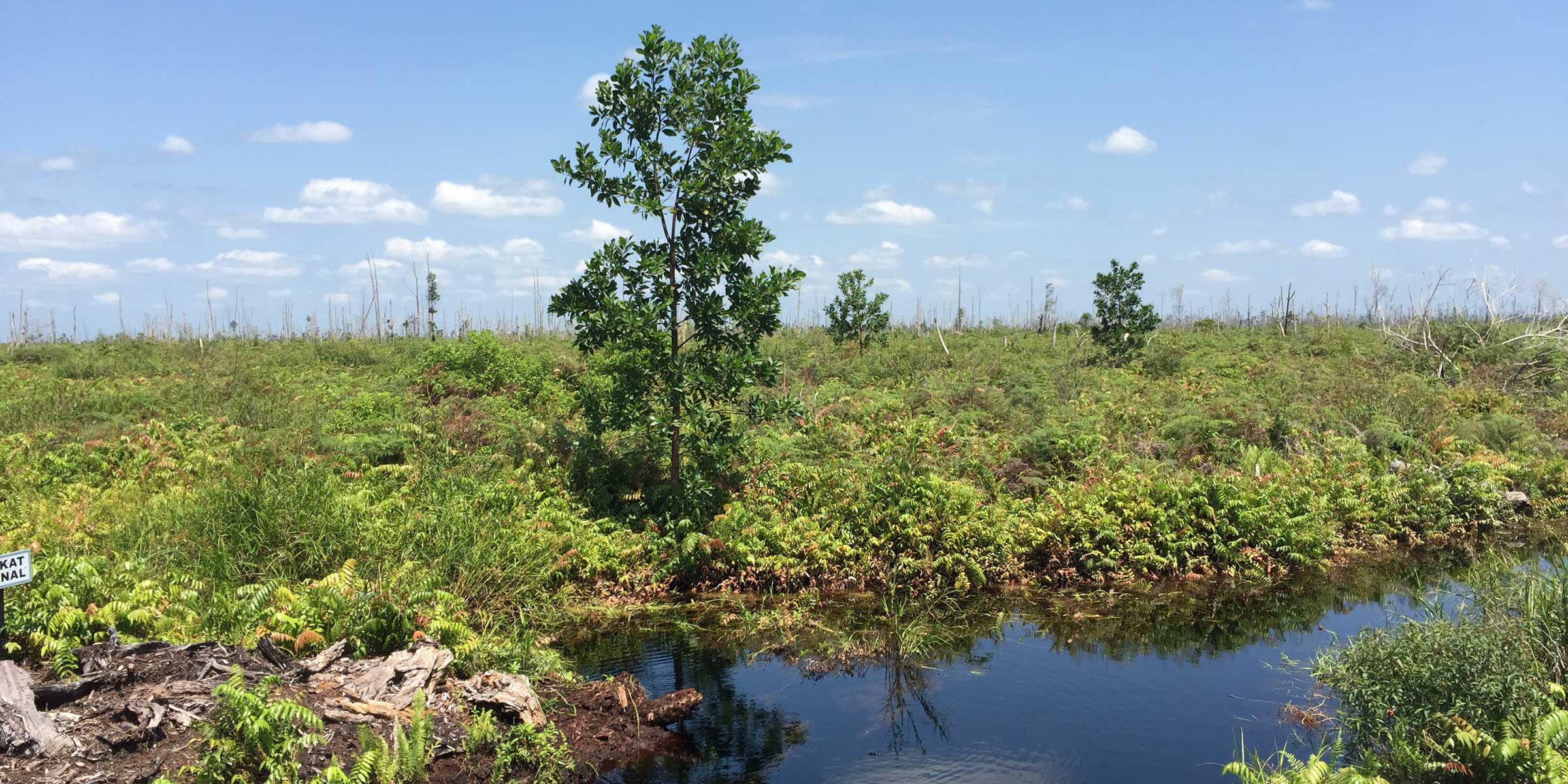
View of cleared peatland with secondary vegetative regrowth and a drainage canal in the foreground. This was once heavily forested wetlands before being drained and logged.


